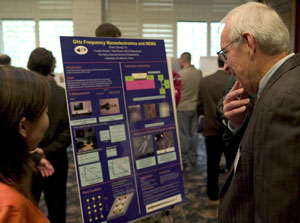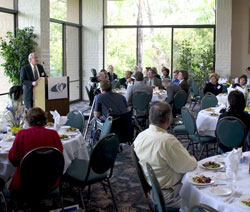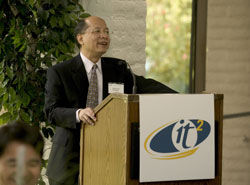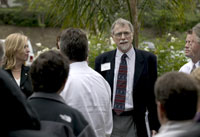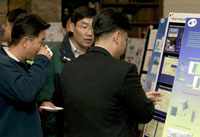Calit2 Day@UCI Celebrates Three Milestones
By Anna Lynn Spitzer
|
11.07.03 -- The first-ever Calit² Day@UCI November 3 celebrated at least three milestones. First, it introduced Albert Yee, the new UCI division director to the Calit² community. Yee assumes his post formally on January 1. Second, it celebrated the award of a large NSF Information Technology Research grant of $12.5M to conduct research on "Responding to the Unexpected," focusing on first responders and more effective collective, analysis, and distribution of information in crisis situations. This grant is the largest NSF research grant to be received by the UCI division and includes researchers on both Calit² campuses. And, finally, the event showcased construction progress of the new Calit² building. UCI's facility will be the first new building to be occupied in the Cal ISI program.
The event, attended by 150 faculty, students, industrial partners, and Calit² staff, featured a poster session with more than 60 entries and tours to the construction site, the Integrated Nanosystems Research Facility, and Falko Kuester's visualization lab. It also included demos of a Wi-FI-based mobile video and audio conferencing prototype and KITTY (Keyboard Independent Touch Typing), a finger-mounted keyboard for wearable computers, pocket PCs, and PDAs.
|
|||
|
Keynote presentations were made by Yee and Sharad Mehrotra, one of the PIs (with Ramesh Rao, UCSD Division director) on the ITR grant. UCI Chancellor Ralph Cicerone, in introducing Yee, pointed to the fact the Yee had improved the ranking of the department of Materials Science and Engineering at the University of Michigan from the top 20 to among the top 5-7 in the country and hoped for a comparable record of success in the UCI division of Calit².
Yee considered this event the start of formal engagement with Calit², although he's been working, remotely, with Calit² leadership to effect the transition. While he's new to UCI, he said it has not taken long to recognize the outstanding leadership and great talent at UCI - "two of the most critical ingredients in making great things happen." He pointed to Smarr's "breathtaking vision and leadership," describing him as a tireless cheerleader and proponent for Calit². "If Larry had been a football coach at the University of Illinois, they would have had a better football team," he joked. Yee also thanked UCI interim division director Bill Parker for "keeping the UCI division on course and making the right decisions based on your wisdom and academic values."
Yee said the primary reason he accepted the position was the breadth of the Calit² vision. "The result," he said, "will be nonlinear development of entirely new things we can't even begin to imagine." The institute will enable new technologies and ways of thinking to benefit industry and the larger community. "The job of the institute," he said, "is to encourage and facilitate these interactions, provide support, and publicize the accomplishments so that the work benefits not only the academic community but industry and the people whose tax dollars make this institute possible."
Yee's area of expertise, polymers and soft materials, falls into the Calit² Materials and Devices layer, which Yee described as the "beginning of the 'food chain.' Information must be sensed and transmitted - that's where M&D comes in, and it will play an important role in the development of Calit²." He emphasized, though, that information technology still plays the central role.
Yee described, as his greatest asset, his profound appreciation for the consequences of interdisciplinary collaboration and the possibilities that result from it. And, after three years leading the Institute of Materials Research and Engineering in Singapore, he understands the importance of motivation. "When people are motivated," he said, "they can do truly astounding things," citing early Calit² examples such as AUTONET, BIRN, the recent ITR grant, and the construction project as "the very embodiment of the progress Calit² is making."
Calit² director Larry Smarr, in introducing Mehrotra, described the new ITR grant as the "poster child" of two-campus collaboration and the largest NSF-funded computer science research grant awarded this year. "Every computer scientist in the country wants one of these," he said. "380 ITRs have been awarded. And this is the second year in a row in which a Calit² proposal has won the largest ITR. That's a great track record!"
Mehrotra then had the opportunity to describe the ITR project, which has generated renewed enthusiasm in recent days due to the firestorms over much of southern California. Called the RESCUE project, where RESCUE stands for RESponding to Crisis and Unexpected Events, its research program includes participation from the University of Illinois, Urbana-Champaign; Brigham Young University; Maryland/College Park; ImageCat; the cities of Los Angeles, Irvine, and San Diego; the County of Los Angeles; and the State of California.
The goal of the project is to transform the flow of information in crisis situations to provide access to the right information at the right time so that responders can take appropriate and efficient action.
Mehrotra, who worries that the "story of how this came to be might become lost in time," emphasized at some length the process by which the team was formed. "The project began as a grassroots effort from several faculty at UCI and UCSD in reaction to 9/11," he said. "We established a core team and participated in national workshops hosted by NSF and DARPA. We realized early on we needed to engage with the first-responder community."
The team also decided to host a crisis response workshop at UCI 18 months ago. Some 75 people from a myriad of organizations participated, including NSF, local industry (Cox, Raytheon, Conexant), other university partners, and neighboring schools. Through panels, breakout sessions, and lots brainstorming, the group began solidifying relationships with emergency responders.
"We wanted to do some small experiments before pursuing outside research grants," said Mehrotra. One was to deploy systems to enable streaming video and real-time data analysis during SuperBowl last January, working with the San Diego Police Department. "This experiment allowed us to understand more about the complexity of large-scale operations and what our partners really want." Two things were of particular interest: latency response (that is, how long does it take to get a response?) and crisis cascade (understanding how an initial crisis can have secondary and tertiary effects). "We have to be careful," said Mehrotra, "that the technologies we devise are non-intrusive so as to not interfere with responders doing their jobs."
The team came close to getting funded in the first round of ITR grants. "We realized, though, from review comments," said Mehrotra, "that what we were missing was an understanding of how humans behave in the context of disaster. That's when we realized we needed to reach out to social scientists." The rest, as they say, is history.
Concluded Mehrotra, "Calit² was the natural vehicle to get this project going and it continues to support us. We already have space in the research park alongside campus, and we're pleased to have a demo and posters to show you today."
|
Related Links
RESCUE


